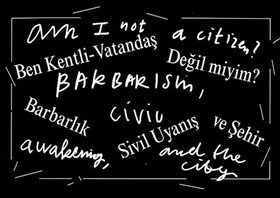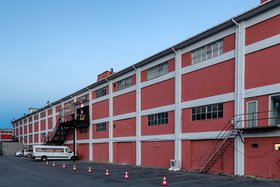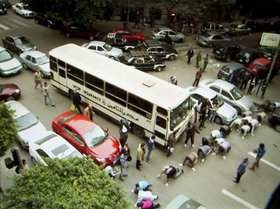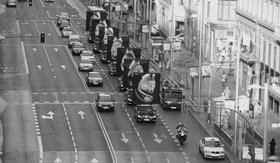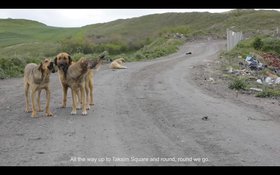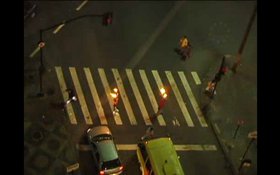Reviews
Dancing with Barbarians
The 13th Istanbul Biennial
The 13th Istanbul Biennial went by the title Anne, Ben Barbar Miyim?/Mom, Am I Barbarian? It was a heartfelt and genuine attempt by its curator, Fulya Erdemci, to grapple with what can only be deemed an impossible task. From the outset, Erdemci had proposed that her exhibition would 're-think the concept of multiple publics, and the public domain as a political forum.' However, as the events surrounding the fight for Gezi Park began in May 2013, many continued to utter that Erdemci's proposal had already manifested publically. As the activism in Istanbul continued, rumours spread far and wide about the biennial's content and structure. Up until I arrived in Istanbul for the official preview, there was no artist list to be found online, and the exhibition's press release did not so much as hint at a suggestion of what the biennial's main exhibition might include by way of art.
I was informed through first-hand accounts that artists who were invited were uncertain where their work would be located, for it was shortly before the biennial's opening that it was decided that the event would withdraw completely from public space – bypassing the government bureaucracy of attaining permissions to display work by moving itself indoors. Its public programme, to be co-curated by Andrea Phillips, was also cancelled. Apparently, in the lead up, there were calls to boycott the event. Others – such as the artist Ahmet Ögüt – proposed alternative possibilities for the international event, arguing for an anonymous biennial that would organically see its artists responding to the city, and the curator removing her weighted hand from the mix. Of course, by the point that Ögüt released his letter, it was but a month before the biennial; the artists had been invited and the works had been chosen, offering too little time for such drastic change to be enacted. Still, his comments swirled in the consciousness of many of the festival's visitors.
This year's biennial also took place shortly before the launch of a new art fair, Art International, which included a mixture of curated public programmes and a high-calibre selection of galleries. The timing of this event reminded me just how 'private' Istanbul's art infrastructure is. Indeed, most major contemporary cultural institutions within the city are privately funded. My favourite of these organisations, SALT, is funded by Garanti Bank; Akbank naturally governs Akbank Sanat; Istanbul Modern, which on the surface resembles a public museum, is in fact a wholly private initiative; while Arter was initiated by the Koç family (who are also the main sponsor of the Istanbul Biennial). On the other hand, the city operates a successful commercial gallery structure, with examples such as Galeri Non, Rodeo, Pi Artworks, Rampa, and Egeran Galleri, to name a few. With such specific private and commercial interests at play, how then does one negotiate the mere notion of 'publicness', in a city where the art scene is, in and of itself, the result of a small group of people's interests, which are not known fully to the public?
The biennial began with a press and professional view on 11th and 12th September, without the usual opening party or launch events. The Dutch Embassy did oblige nevertheless by putting on an uptight reception for the exhibition's curator, Fulya Erdemci. Erdemci also runs an institution in the Netherlands called the Foundation for Art and Public Domain (SKOR), an organisation which ironically had its 'public' funding from the Dutch government entirely cut during the recent financial restructuring of Holland's cultural sector. By this point, frustrated and antagonistic comments were swirling amongst local and international arts professionals. Some complained the biennial was too literal, while others contrastingly argued it was too abstract. One critic mentioned 'poor exhibition design' and sound bleed amongst video works. 'There was nothing worth seeing in Antrepo 3', one international curator informed me. Antrepo – a mainstay venue for the biennial over the years – boasted the largest selection of works. It opened with the only 'public' piece of the exhibition, Ayse Erkman's bangbangbang (2013): a wrecking ball seen banging against the side of the building. This, it was rumoured, was a literal comment on the fact that this historic biennial venue will soon be sold off, and possibly converted into a hotel or other private enterprise.
One of the most gripping works in this context was a piece by the late Egyptian artist Amal Kenawy, entitled Silence of Sheep (2009). The video is documentation of a performance staged in Cairo, in which the artist led fifteen people (whom she paid) crawling on all fours through the streets of Cairo during rush hour. As the performers stop traffic a public fight ensues, which sees the artist being confronted verbally and physically by members of the public, most of whom are men. As the arguments ensue, we start to witness Kenawy defending her practice, as she opens up questions about the role of contemporary art in Egyptian society. Struggling in these tense moments, the artist draws parallels with satire and popular culture to explain her position to those who are confronting her. In these instances, the complete disconnect between the mass population of Egypt and the city's small and isolated art scene becomes apparent.
It was refreshing to see this work nearby that of Santiago Sierra, whose practice could arguably be seen as a direct inspiration for Kenawy's piece. Of the two works Sierra presented, the more interesting was his collaboration with Jorge Galindo, Encargados (2012) – a black and white film which acted as a response by the artists to the socioeconomic crisis in Spain.
Elsewhere, Mika Rottenberg presented an engrossing film called Squeeze (2010). Here, Rottenberg positions women as objects of desire by exploring the relationship between femininity, labour and hygiene. She constructs a hilarious and astute visual tapestry that sees her protagonists occupying tiny, box-like spaces, producing boxes of rubber, lettuce and blush. The artist takes the rigid repetition of the factory line and punctures it with moments of imaginative slapstick: close-ups of grotesque bodies swelling and overtaking the frame, for instance. This emphasis on form was complemented nicely by Gonzalo Lebrija's Lamento (2007), a tiny white sculpture of a man with his head buried in his right hand.
Booming at the end of the Antrepo was Halil Altindere's Wonderland (2013), a large-scale film that sees young Roma kids rapping about their frustrations at having been forced out of Istanbul's Sulukule neighbourhood. It is suggested that this is due to gentrification. Many claimed this work to be a highlight, but its rap-video aesthetics felt a little too heavy-handed for this viewer. Altindere's attempt at merging provincial issues with mimetic nods to popular culture seemed confounding to me, as the connotations of mainstream rap culture (of violence, chauvinism, and racism) are arguably stereotypes the Roma community should be attempting to evade.
Across from Antrepo, at the Galata Greek Primary School, lay the figurative heart of Erdemci's biennial exhibition: a film about Istanbul poet Lâle Müldür (whose book Mom, Am I Barbarian? inspires the biennial's title), which follows the eccentric poet as she performs for the camera. This collaborative work, developed with Kaan Karacehennem and Franz Von Bodelschwingh, is a portrait of Müldür as she tries to enact her poetry into the form of a feature film, Violent Green (2013). The exhibition's catalogue reveals the poet's desire to foray into cinema; 'Yes, life is a long way while the cinema is guerilla warfare…it searches for the unhabitual philosophy of life and death, as well as the barbarity of the soul'.
The school also included emotional works by Basim Magdy, and a whimsical video by Annika Eriksson, I am the dog that was always here (loop) (2013). Here, the artist constructs a peripheral 'no man's land', focusing on the fictitious existence of stray dogs that have been forced out of the city due to processes of urban redevelopment.
The largest work at the Galata Greek Primary School was a collaborative project that could be found upon first entry to the school, but that could only be observed from above. Here, a closed pop-up space was developed as a discursive environment for different art students (who applied through an open call) to debate, work and perform. The project (for which I cannot seem to find the names of the artists involved) feels appropriate within the context of Erdemci's thesis, suggesting that a 'shared space' can be nurturing, generative and formational. Of course, the outcomes of such an initiative are yet to be revealed. Whether they should be shared is another matter entirely.
Other biennial venues included Arter and the 5533 project space. Significant contributions included works by Basel Abbas, Ruanne Abu Rahme's The Incidental Insurgents (2012-2013), Cinthia Marcelle's Confront (2005), and Maxime Hourani's durational project, which sees him constructing a book of songs and places over the course of the biennial.
Although it may impossible to extricate from the day-to-day disruption of Istanbul's civil society, looked at it on its own, the 13th Istanbul Biennial can be read as an imperfect but complementary proposal to the global biennial discourse. dOCUMENTA(13), the 11th Sharjah Biennial, the 7th Berlin Biennial, La Triennale: Intense Proximity, the 55th Venice Biennial, and now the 13th Istanbul Biennial, all share common threads in their construction. Collectively, these exhibitions propose and argue for new approaches to exhibition making. Core to all of these is a desire to decenter exhibitions from the rigid canon of art making, such as the regional/national borders that inform artist selection, and the formal, aesthetic and theoretical tropes, which inform artist projects. Looked at together, they propose that culture as a field is far too hyperlinked, intertwined and networked to exist in a vacuum, and instead must lend itself to being subsumed by other forms. Still, with the intense oversaturation of this very culture, we start to notice mimetic trends in the canon of large-scale exhibition making. To me, the 13th Istanbul Biennial feels like it should – indeed, must – be the final segment in this global biennial/quadrennial chapter, and leaves us with the urgent question: where do we go from here?

